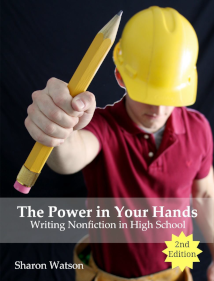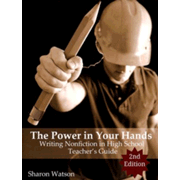Sharon Watson’s Jump In writing course for middle school students made my Top Picks list, so I definitely was interested in reviewing her course for high school students, The Power in Your Hands: Writing Nonfiction in High School.
As you can tell by the title, the high school course teaches nonfiction writing. It covers the structure of an essay as well as various types of essays: opinion, persuasion, comparison/contrast, biography, descriptive, “how-to,” newspaper writing, definition, devotional, personal testimony, personal narrative, and literary analysis. In addition, students write various types of letters and learn e-mail etiquette.
Many high school courses begin with paragraph structure, and gradually move into essay writing, but Watson assumes that students have mastered the paragraph and jumps right into essay writing. However, as she does so, she teaches the writing process and basic composition techniques for students who might not yet have learned them. Nevertheless, this is a college-prep course that covers essays and other types of writing that will be required for college, the work world, and real life. Literary analysis—often skipped in high school composition courses—is also covered quite well here with lessons that include instruction on characters, conflict, plot, voice, and other aspects that need to be considered.
The course is suitable for all situations: traditional classrooms meeting daily, co-op groups meeting once or twice a week, or independent study. All students need some interaction with a parent or teacher. While students benefit from the interaction of a group class, it isn’t required by this course. The 415-page, self-guided student text makes it easy for students to work independently, although parents should be checking textbook exercises and evaluating written work on a daily basis. Some student exercises might be completed directly in the student text while many will need to be done in a separate notebook.
The teacher’s guide is essential. It includes answer keys for some of the exercises with predictable answers. Thirty-one pages of the teacher’s guide explain grading and evaluation strategies and include evaluation forms that you can copy and use. Samples of student essays are included throughout the course, so both students and teachers have a sense of what is required.
Students are taught to edit their own work. A chapter is devoted to developing proofreading skills, and the “student toolbox" at the back of the text provides the evaluation forms, guidelines for proofreading, and particular points to check for various types of writing. All of this makes it easy for both the student and the parent/teacher to use this course.
The course might take a year or more to complete. There are 23 chapters, but the chapters vary in length and design. In the student book, lessons are conveniently divided into lessons so it is clear what should be completed each day. However, some lessons will take longer than one day. For instance, after the seventh lesson in the chapter on “The Position Paper and Documentation,” students are provided with a 12-day schedule for actually researching and writing a paper using MLA documentation. Some other papers also require research and reading that takes more time.
Even if writing a researched paper seems daunting for your student, Watson makes that skill as well as the others taught in this course very attainable by teaching them in increments with instruction, encouragement, and examples. Watson’s casual and friendly writing style and her injection of humor also help students overcome any aversion to writing.
You can expand the course and develop students’ writing skills even further by using the “14-Minute Power Surges Program” in the teacher’s guide. The program presented there has writing prompts for four days per week for September through May. Students write each day for about 14 minutes. On the fifth day, students select their favorite paper from that week to proofread, polish, and turn in on Monday. The creative and inspiring writing prompts range through both creative and expository writing. For example, “Come up with three uses for cotton swabs other than cleaning your ears” might inspire some creative thinking, while “Make a list of qualities you are looking for in a future spouse" will probably be factual and straightforward. The writing prompts might be used while teaching the rest of the course or after its completion.
The course reflects a Christian viewpoint. It’s written in a way that a Christian teacher with an audience of Christian students would experience as a matter-of-course. For example, persuasive essay lessons mention hot-button topics like the morality of suicide and the use of embryonic stem cells. The entire chapter on writing a researched position paper uses the topic “icons of evolution” as its exemplary theme. This does not mean that every lesson is connected to scripture or spiritualized in some way. Watson is obviously in touch with the broader literary world with references to well-known authors and their works, and she’s also in touch with her students’ world as you can tell from her occasional references to popular culture.
The Power in Your Hands makes an excellent follow-up course for students who have completed Watson’s Jump In course or others such as Janie Cheaney’s Wordsmith: A Creative Writing Course for Young People or Karen Newell’s Write On! Even inexperienced homeschoolers and those who have no confidence in their ability to teach students how to write should find it easy to use.













